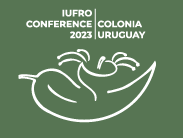Moving towards a rolling front strategy for VERACEL's advanced-generation eucalypt hybrid breeding program
DOI:
https://doi.org/10.31285/AGRO.27.1254Abstract
The eucalyptus breeding program at VERACEL started in the mid-1990s driven by the objective of producing outstanding clones adapted to the Bahia South (Brazil) environment, and thus creating highly productive stands with high quality pulpwood. The breeding population initially comprised several introduced pure species collections (mainly E. grandis and E. urophylla) from Australian provenances and ex-Brazilian hybrids (mostly E. urophylla × E. grandis). These populations were first structured according to a typical reciprocal recurrent selection scheme to identify outstanding urograndis F1 hybrids. In the early 2000s, the program developed and tested several second-generation F1 hybrids, in addition to some progeny and clonal trials with a few introduced new species and hybrids. More recently, starting in 2016, a new set of F2 progeny and clonal hybrid trials were established from previously selected F1 parents. This second generation of hybrids was complemented with other 2-way and 3-way hybrid crosses to form an advanced generation synthetic population. To manage such breeding population, including pure species, F1 and advanced F2 hybrids, and backcross hybrids, VERACEL is restructuring its breeding program to implement a more flexible multispecies rolling front selection and mating scheme. This would allow the strategy to effectively combine all available phenotypic and pedigree information. Currently, the database, spanning three generations of breeding, includes 105 progeny and clonal trials, over 2,300 individual clones, and more than 30,000 pure and hybrid seedling progenies. We expect that the breeding and selection strategy will ensure optimum long-term progress in the additive genetic merit of selected parents, as well as exploit the hybrid heterosis and non-additive genetic effects to identify outstanding clones in the short term. Our study describes in some detail the current state-of-the-art of VERACEL’s breeding and clonal populations, and discusses key elements of this strategy. We discuss the challenges posed by the increasing relevance of good adaptations to climate change and diseases, and the complex genetics of inter-specific hybridization, especially as the program enters its 3rd generation of testing and selections.
Downloads

Downloads
Published
How to Cite
Issue
Section
License
Copyright (c) 2023 Agrociencia Uruguay

This work is licensed under a Creative Commons Attribution 4.0 International License.
| Article metrics | |
|---|---|
| Abstract views | |
| Galley vies | |
| PDF Views | |
| HTML views | |
| Other views | |















